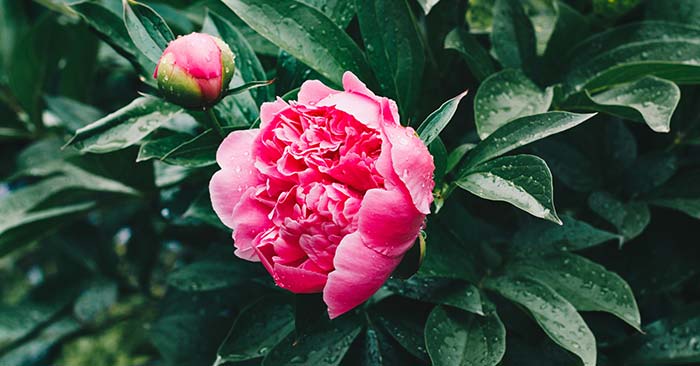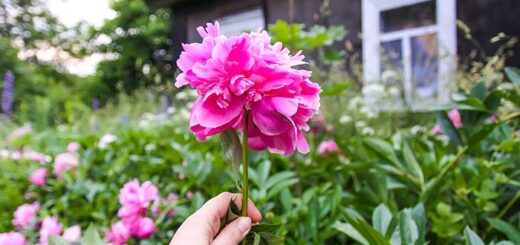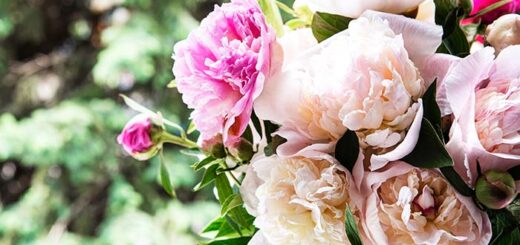Peony Growth Stages: A Comprehensive Guide
Understanding the life cycle of peonies is essential for gardeners looking to nurture these stunning plants. Peonies go through several distinct growth stages, from their initial emergence in spring to their dormancy in fall.
This blog will explore each stage in detail, providing insights and tips to help you grow healthy, thriving peonies.
Introduction: The Journey of Peonies
Peonies are admired for their beauty and resilience. These perennial plants re-emerge from the ground each year, bringing joy to gardens season after season.
Their life cycle is fascinating, beginning with dormancy in fall and culminating in a spectacular floral display in spring.
Understanding the different growth stages of peonies will help you provide the care they need at each stage, ensuring a healthy and bountiful bloom.

Image Source: Envato Elements
Stage 1: Shoot Development
The first stage in the peonies’ growth cycle is shoot development. As temperatures rise and water absorption increases, peony shoots start to grow. This regrowth typically begins after the frost season has passed. During this stage, the plant awakens from its dormant state, and new shoots begin to form underground.
Tip: Ensure the soil is well-drained and rich in organic matter to support healthy shoot development.
Stage 2: Shoot Emergence
Once the shoots have developed, they begin to emerge above the ground. This is a critical stage where the baby leaves remain folded, and the shoots start to stretch. As the shoots mature, they become more visible, signaling the start of the active growing season.
Tip: Protect emerging shoots from late frost by covering them with mulch or a frost blanket if necessary.
Stage 3: Leaf Opening
As the shoots continue to grow, the leaves begin to open. This stage is marked by the unfolding of curved leaflets and the appearance of flower buds. By the end of this stage, peony stems can reach up to two to three feet in height.
Tip: Monitor for pests and diseases during this stage, as the young leaves can be susceptible to damage.
Stage 4: Leaf Extension
The leaves expand outward during the leaf extension stage, taking their final shape. This stage also sees the emergence of flower buds on the upper leaves. The plant’s energy is focused on leaf and stem growth, setting the foundation for a strong blooming phase.
Tip: Ensure the peonies receive adequate sunlight for healthy leaf and bud development.
Stage 5: Bloom Bud Expansion
In this stage, the bloom buds grow significantly larger, eventually reaching the size of a golf ball. This is a sign that the plant is preparing for its blooming phase. The anticipation of the vibrant flowers soon to come adds excitement to the gardening experience.
Tip: Support the stems with stakes or a peony cage to prevent them from bending or breaking under the weight of the buds.
Stage 6: Bud Coloring
Bud coloring is the stage where the bloom buds begin to open, and the color of the blossoms becomes visible. This stage is a prelude to the final bloom, with the buds showing their first hints of the vibrant colors that peonies are known for.
Tip: Regularly check for any signs of disease or pest infestation and address them promptly to protect the developing buds.
Stage 7: Flower Opening
The final stage in the peony growth cycle is flower opening. This is the moment every gardener waits for, as the flowers fully open and display their significant features. Peonies’ blooms are a sight to behold, showcasing a variety of colors and forms depending on the cultivar.
Tip: Deadhead spent blooms to encourage more flowering and prevent the plant from putting energy into seed production.
Additional Tips for Growing Healthy Peonies
- Soil Preparation: Peonies thrive in well-drained, fertile soil with a pH between 6.5 and 7.5. Adding compost or well-rotted manure can improve soil quality.
- Planting Depth: When planting peony roots, ensure the eyes (buds) are no more than 1-2 inches below the soil surface. Planting too deep can prevent blooming.
- Watering: Peonies require consistent moisture, especially during dry spells. However, avoid waterlogging, as peonies are prone to root rot.
- Fertilization: Apply a balanced fertilizer in early spring and again after flowering to support growth and blooming.
- Mulching: Mulch around the base of the plants to conserve moisture, regulate soil temperature, and suppress weeds.
FAQs About Growing Peonies
Q: How often should I water my peonies?
A: Peonies should be watered deeply once a week, especially during dry spells. Ensure the soil is moist but not waterlogged. Overwatering can lead to root rot.
Q: When is the best time to plant peonies?
A: The best time to plant peonies is in the fall, ideally between September and early October. This allows the roots to be established before winter.
Q: Can peonies grow in containers?
A: Yes, peonies can be grown in containers, but choosing a large pot with good drainage is essential. Use high-quality potting soil and ensure the container receives adequate sunlight.
Q: How do I divide peonies?
A: To divide peonies, carefully dig up the plant in the fall, shake off excess soil, and use a sharp knife to cut the root clump into sections, each with at least 3-5 eyes. Replant the divisions at the same depth as the original plant.
Q: What should I do if my peony leaves turn yellow?
A: Yellowing leaves can indicate several issues, such as overwatering, poor drainage, or nutrient deficiencies. Check the soil moisture, ensure proper drainage, and consider applying a balanced fertilizer.
Q: How long do peonies live?
A: Peonies are long-lived perennials and can thrive for decades with proper care. Some peony plants have been known to live for over 100 years.
Q: Are peonies toxic to pets?
A: Peonies are toxic to pets, especially dogs and cats. Ingesting peony plant parts can cause vomiting, diarrhea, and lethargy. Keep pets away from peony plants to prevent any issues.
Q: Can I grow peonies from seeds?
A: While it is possible to grow peonies from seeds, it is a slow process that can take several years for the plants to reach maturity and bloom. Most gardeners prefer to plant root divisions for quicker results.
Q: What type of fertilizer is best for peonies?
A: A balanced, slow-release fertilizer with equal nitrogen, phosphorus, and potassium (10-10-10) is ideal for peonies. Apply it in early spring and again after the flowering period.
Q: How do I prevent peonies from flopping over?
A: To prevent peonies from flopping, use peony rings or stakes to support the stems. You can also plant peonies sheltered to protect them from strong winds.
Q: Why are my peony buds not opening?
A: Peony buds may fail to open due to insufficient light, poor nutrition, or damage from pests or diseases. Ensure the plants receive adequate sunlight, fertilize appropriately, and check for any signs of pests or diseases.
Q: Can I transplant peonies during the blooming season?
A: It’s best to avoid transplanting peonies during the blooming season, as this can stress the plant and affect its growth. The ideal transplant time is in the fall after the plants have gone dormant.


